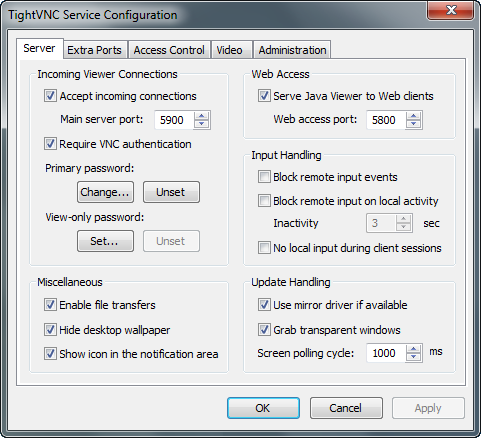 Er zijn verschillende programma's om computers op afstand te besturen. TightVNC is zo'n programma en zoals de naam al aangeeft, maakt het gebruik van VNC. 'Tight' slaat op het gebruik van compressie, waardoor het programma ook goed presteert over trage verbindingen. Sinds versie 2.0 is TightVNC alleen voor Windows 2000 en hoger geschikt, Windows 9x/NT- en Linux-gebruikers moeten versie 1.3.10 blijven gebruiken. Nieuw in versie 2.5 zijn onder andere aparte 32bit- en 64bit-downloads, DFMirage en een snelle mirror-videodriver, en er is volledige ondersteuning voor Unicode. Versie 2.5.2 is een zogenoemde bugfix-release en bevat de volgende verbeteringen:
Er zijn verschillende programma's om computers op afstand te besturen. TightVNC is zo'n programma en zoals de naam al aangeeft, maakt het gebruik van VNC. 'Tight' slaat op het gebruik van compressie, waardoor het programma ook goed presteert over trage verbindingen. Sinds versie 2.0 is TightVNC alleen voor Windows 2000 en hoger geschikt, Windows 9x/NT- en Linux-gebruikers moeten versie 1.3.10 blijven gebruiken. Nieuw in versie 2.5 zijn onder andere aparte 32bit- en 64bit-downloads, DFMirage en een snelle mirror-videodriver, en er is volledige ondersteuning voor Unicode. Versie 2.5.2 is een zogenoemde bugfix-release en bevat de volgende verbeteringen:
What's New in Java ViewerWhat's New in Viewer for Windows
- Introducing new full-screen mode, with optional auto-scaling, auto-scrolling and a pop-up toolbar.
What's New in Server for Windows
- Fixed authentication handling in RFB protocol version 3.7. This should resolve connectivity problems with Ubuntu systems and Vino servers.
- Fixed hang-up on changing language or keyboard layout. To fix this problem, Windows message handling has been re-designed completely.
- Fixed priority of preferred encodings. Previous version could work inefficiently with servers that do not support Tight encoding, because the viewer could choose uncompressed Raw encoding instead of well-compressed ZRLE.
- Eliminated 34-character limit on hostnames in the New Connection window.
- Using correct line ending characters in cross-platform clipboard transfers.
- Introduced a number of improvements and fixes in the user interface. That includes new commands in the toolbar and in the system menu, and architectural changes such as restoring the option to start new connections from the same Viewer instance.
- Adjusting viewer window size on remote desktop resizing.
- Other minor improvements and fixes.
What's New in Installer for Windows
- Fixed a problem with querying local users on incoming connections. TightVNC has a feature to let local user approve or reject incoming connections. If there was no user action within a pre-configured time limit, new connection will be either accepted or rejected automatically. Unfortunately, the timeout setting did not work correctly in previous version and that could result in infinite timeouts. That has been fixed.
- Fixed the Apply button in the Configuration window — it stayed disabled on editing configuration settings.
What's New in the C++ Source Code
- Added new MSI installer properties, to automate pre-setting passwords in silent mode.
- Improved logging architecture. The changes will not be visible to end user, but developers will appreciate new logging system. There should be no more static methods and global log objects, so it will be easier to reuse separate components in third-party applications. Now all components work via a simple logging interface or can work without logging at all.
- Corrected build problems in various combinations of build configurations and platforms, in both Visual Studio 2008 and Visual Studio 2010.


:fill(white):strip_exif()/i/2002906382.jpeg?f=thumbmedium)